•••
The Coconut Cow
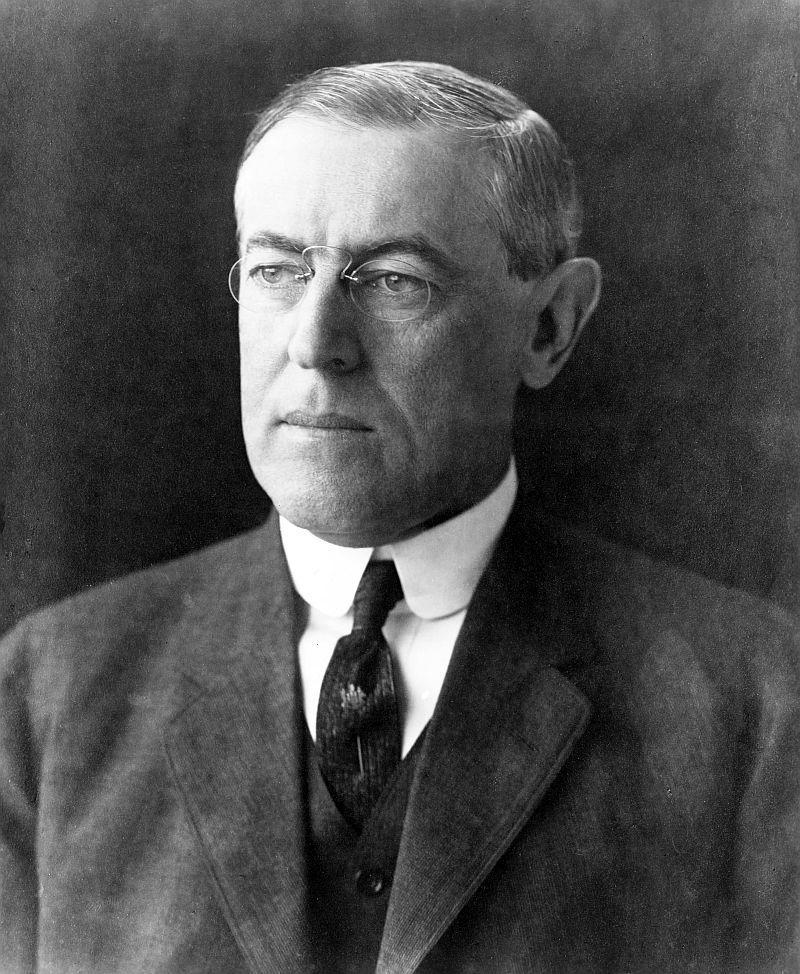 Despite his conviction for conspiracy to evade the tax on yellow oleo, John F. Jelke did not serve any time in prison. During the eight-year ordeal from arrest to conviction to exhaustion of all appeals, Jelke had been represented by Chicago attorney John Barton Payne, a Democrat. In February 1920, Payne was appointed Secretary of the Interior by President Wilson. Within weeks of Payne’s appointment, and shortly before Jelke was scheduled to be sent to Leavenworth, President Wilson granted the oleomargarine king a pardon. With prison removed from his future, Jelke was soon back at the front lines of the color wars.
Despite his conviction for conspiracy to evade the tax on yellow oleo, John F. Jelke did not serve any time in prison. During the eight-year ordeal from arrest to conviction to exhaustion of all appeals, Jelke had been represented by Chicago attorney John Barton Payne, a Democrat. In February 1920, Payne was appointed Secretary of the Interior by President Wilson. Within weeks of Payne’s appointment, and shortly before Jelke was scheduled to be sent to Leavenworth, President Wilson granted the oleomargarine king a pardon. With prison removed from his future, Jelke was soon back at the front lines of the color wars.
Jelke had originally hoped that both his sons would join his margarine business, and for a time it looked like his plans would come true. Their trip to Hankou to buy Chinese duck eggs had introduced them to the business, and both seemed to be oleo men—smart, hardworking and aggressive. The eldest, Ferdinand Frazier Jelke, was called either Ferd or Ferdie by the family but later in life used his middle name as his first. After graduating from Yale University in 1902, Frazier joined the margarine world, working first by his father’s side as a vice-president of The John F. Jelke Company and then as the president of a subsidiary, The George P. Braun & Company. In 1907, Frazier married Clara Bartholomay, the beautiful daughter of a Rochester, New York, beer brewer. Her father’s company, Bartholomay Brewing Company, also controlled the Rochester Brewing Company and the Genesee Brewing Company.
The marriage teetered from the start. It lasted but three years. She liked spending his money but otherwise did not care for him. After giving birth to a son, Clara sued for divorce. The suit quickly became a sensation, and Frazier Jelke became the first oleomargarine heir to make headlines as the divorce was headlined day after day in the newspapers. In the first years of the 20th Century, the newspaper industry was at the height of its power and influence. It was the only source of daily news, and publishers like William Randolph Hearst and Joseph Pulitzer knew that to sell papers, stories about current events and politics were not enough. Hearst and Pulitzer had learned that news was a commodity that could be packaged and sold, like margarine. The public wanted to be entertained not just informed. The public wanted stories about crime, sex and tragedy, and the tabloids satisfied that desire. Frazier’s divorce was perfect—a story of money and sex that could be played out edition to edition. Frazier would have none of it, however, and tried to truncate the story. As he later explained in his autobiography: “In those days, divorce was serious. The press and the gossip-mongers made much of it. I entered no defense—a gentleman allowed himself to be divorced without retaliation or even self-defense.” But Frazier had not simply conceded without a fight. He was willing to let his wife have the divorce, but he wanted vindication. He sued Clara’s father for alienation of affection, charging that the marriage had disintegrated because of parental meddling. And he began a custody battle over his son, Frazier Bartholomay Jelke, who was called Bart. The custody battle would last 10 years: each round carried by the newspapers. Although the court eventually awarded Frazier custody, Clara had made its decision moot by taking young Bart beyond the court's powers to Europe. There, she married into aristocracy.
Despondent after the divorce, Frazier escaped to France. After a year, he returned to Chicago and resumed the presidency of The George P. Braun & Company, which manufactured Prairie Queen margarine, identical in substance to Good Luck but packaged and marketed differently. Frazier proved to be as good a margarine drummer as his father and grandfather: he quickly started outselling Good Luck margarine in certain states, which made his father proud as a parent and furious as a businessman. For every pound of Prairie Queen that Frazier sold, one less pound of Good Luck was sold. Frazier’s father decided to absorb the company and replace Prairie Queen with Good Luck. Frazier was sent east, where he opened a branch office for The John F. Jelke Company in Boston and summered in the Hamptons. He made many connections with the New York financial world. Frazier had been thinking about starting his own margarine company, perhaps in New York’s Orange County, but his father did not want to compete with another rival, particularly one run by Frazier. At the time, John F. Jelke was battling the tax evasion charges on one front and the butter forces on another. He wanted Frazier to take over the family business, but that would not happen for years, and he doubted that there was a future in margarine—at least, not a lucrative future. John F. Jelke urged Frazier to enter Wall Street.
Frazier considered himself “a butter-and-egg man from the Middle West” (even in this description avoiding the mention of the basis of the family’s wealth because of negative connotations associated with margarine), but the idea of Wall Street intrigued him. War in Europe broke out in August 1914, but the United States remained neutral, and a bull market raged on Wall Street the following spring and summer. In late 1916, Frazier, with his father’s backing, entered the brokerage business. His new partners had agreed to teach him the bond business if he put up the capital for the venture. He agreed, and Hood and Bolles opened at 40 Wall Street. Frazier learned the bond business and kept his wanderlust in control, but soon after America entered World War I in March 1917, Frazier enlisted in the Marines, even though he was 37 years old. He had retained much of his French and yearned to go back to the country where he had sojourned after his divorce. He spent nearly two years overseas, returning safely in early 1919. His Wall Street firm soon changed its name to Jelke, Hood & Co. and, with his father’s assistance, Frazier purchased a seat on the New York Stock Exchange. Later, the enterprise would change its name to Frazier Jelke & Co. Using the business connections he had made while in the margarine business, Frazier built a fortune during the booming 1920s. When Frazier’s company struggled after Black Friday—the great stock market crash of 1929—his father’s oleo money provided needed financial capital and security.
After Frazier Jelke left the margarine business for Wall Street, his younger brother became the successor-in-waiting to his father’s Good Luck margarine business. Brody’s grandfather, John F. Jelke Jr., was called Jack. Unlike Frazier, Jack Jelke did not consider himself a “butter-and-egg man.” He was an oleomargarine man, like his father, and he had no independent streak, no wanderlust, no urge to compete with his father. Oleo coursed in his veins, and through the late 1910s and the 1920s, he stood by his father as they continued the fight to put yellow margarine on the kitchen table. During the fifty years between Mège-Mouriés’s invention and John F. Jelke’s pardon, the manufacturing of margarine had developed and become more sophisticated. Mège-Mouriés’s original recipe was replaced. The sheep’s stomach was discarded in favor of allowing the milk to sour slightly before churning it. Hydrogenated oil was introduced into the formula soon after the close of the 19th century, and, by the time of Jelke’s pardon, animal fat was being removed or reduced from the recipe in favor of vegetable oils. The change to vegetable oils was not done solely for health reasons. One of the reasons for the switch was to circumvent the higher tax imposed on artificially colored margarine and the 1909 Supreme Court ruling that margarine with trace elements of amber-colored oils was still within the ambit of the federal law. Jelke had found another loophole.
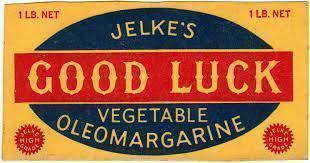 Jelke and other manufacturers had started adding larger quantities of natural oils to their margarine on the theory that the larger the percentage in the final product, the harder it would be to call the coloring artificial. Finally, companies started marketing margarine made with all vegetable oils and no animal fats because the 1886 act, as amended in 1902, did not apply to such products. It was a short-lived victory. These amber-colored vegetable products were derided by the dairy industry as anti-American because the primary oils used—palm and coconut—were foreign. The critics disparaged such margarine as coming from the “coconut cow.” The margarine industry quickly switched to domestic oils—cottonseed, soybean, corn. Jelke, for instance, used a secret blend of different cottonseed oils. The switch to American oils was thwarted as Congress once again came to the dairy industry’s rescue by levying import duties on foreign oils and imposing the higher tax on margarine made with all vegetable oils. The margarine industry was forced to retreat: in order to avoid the higher tax and keep its product cost competitive, it had to switch to neutrally colored oils or, in some instances, it had to bleach the natural amber color from its all-vegetable product. After nearly half a century of struggle, the margarine manufacturers were right back at the beginning—with a product whose only drawback was its white color. The industry was still able to provide separate yellow dye with its white product to be used by the consumer to make yellow margarine. The butter industry had failed to make that practice illegal, but it was small solace.
Jelke and other manufacturers had started adding larger quantities of natural oils to their margarine on the theory that the larger the percentage in the final product, the harder it would be to call the coloring artificial. Finally, companies started marketing margarine made with all vegetable oils and no animal fats because the 1886 act, as amended in 1902, did not apply to such products. It was a short-lived victory. These amber-colored vegetable products were derided by the dairy industry as anti-American because the primary oils used—palm and coconut—were foreign. The critics disparaged such margarine as coming from the “coconut cow.” The margarine industry quickly switched to domestic oils—cottonseed, soybean, corn. Jelke, for instance, used a secret blend of different cottonseed oils. The switch to American oils was thwarted as Congress once again came to the dairy industry’s rescue by levying import duties on foreign oils and imposing the higher tax on margarine made with all vegetable oils. The margarine industry was forced to retreat: in order to avoid the higher tax and keep its product cost competitive, it had to switch to neutrally colored oils or, in some instances, it had to bleach the natural amber color from its all-vegetable product. After nearly half a century of struggle, the margarine manufacturers were right back at the beginning—with a product whose only drawback was its white color. The industry was still able to provide separate yellow dye with its white product to be used by the consumer to make yellow margarine. The butter industry had failed to make that practice illegal, but it was small solace.
In 1930, John F. Jelke decided to retire. He was almost 75 and had grown weary of battling the forces of butter. His dream of being able to sell yellow margarine without federal or state interference remained unfulfilled. With his eldest son established on Wall Street, Jelke turned his oleo empire over to his youngest son and namesake. Very much his father’s son, Jack was a strong business man and a strong family man. He had fared better in marriage than his brother Frazier. In 1922, Jack married Elizabeth Minot Clarke. She was a sophisticated, strong-willed society girl, well-bred and well-schooled. Her father’s family arrived in Massachusetts in 1630, her mother’s, in 1638. Several family members served in the American Revolution, and she later joined the Daughters of the American Revolution. Her father was one of the founders of Pennsylvania Water and Power. By the time Jack took over the family oleo business, he and Elizabeth had had four children. Victory in the color wars had eluded the elder Jelke, but he hoped that his youngest son would conquer the buttermen. The retirement proved short. The oleomargarine king died in 1931.
During the last years of his life, the senior Jelke had given much of his fortune to his two sons, often placing the money in trust for them. When he died, his estate was valued at only $2,000,000—still a vast sum during the Depression. He left all of the estate to Louanna, his beloved wife of 51 years; however, she followed him in death six months later. Like her husband, she had given much of her estate, initially valued at close to $7,000,000, to her two children before her death She had not made a will, and what little was left of the fortune descended to her two sons through the intestate laws of Illinois.
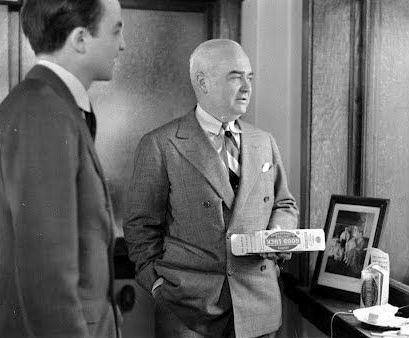 Under the stewardship of Jack Jelke, The John F. Jelke Company solidified Good Luck Margarine as one of the leading brands. The company continued its aggressive advertising. One advertising campaign boasted that Good Luck was the only margarine that was dated for freshness. Another claimed that the margarine would not melt down even at 95 degrees. The company also focused its advertising on the nutritional aspects of its product. By the mid-1930s, the company’s one-pound folding carton boasted that Good Luck was “All-Vegetable.” The company had introduced a new process for making margarine, using liquid vegetable oils. Brody’s grandfather also took out full page ads in Life magazine touting the vitamin content of its product: “It’s true, nurse. The richest woman in town and she gives her children margarine,” a 1937 ad read, subtitled: “Good Luck is rich in vitamin ‘A’… also contains important vitamin ‘D.’”
Under the stewardship of Jack Jelke, The John F. Jelke Company solidified Good Luck Margarine as one of the leading brands. The company continued its aggressive advertising. One advertising campaign boasted that Good Luck was the only margarine that was dated for freshness. Another claimed that the margarine would not melt down even at 95 degrees. The company also focused its advertising on the nutritional aspects of its product. By the mid-1930s, the company’s one-pound folding carton boasted that Good Luck was “All-Vegetable.” The company had introduced a new process for making margarine, using liquid vegetable oils. Brody’s grandfather also took out full page ads in Life magazine touting the vitamin content of its product: “It’s true, nurse. The richest woman in town and she gives her children margarine,” a 1937 ad read, subtitled: “Good Luck is rich in vitamin ‘A’… also contains important vitamin ‘D.’”
During the Depression, while unemployment soared and financial ruin was common, the two oleo heirs, Frazier and Jack Jelke, enjoyed the comfortable high-society. Frazier’s brokerage business had survived the economic free fall and had emerged as one of the stronger investment houses on Wall Street. Jack’s margarine company was also doing well as sales of Good Luck Margarine steadily increased. Frazier and Jack purchased separate mansions in Newport, Rhode Island, and they wintered in Miami or Palm Beach. They dined with the Vanderbilts, drank Martinis with the Rockefellers. Frazier’s only son, Bart, had graduated from Yale. Jack’s older children were in the finest private schools. Life for the oleo heirs was hardly idyllic, however. Jack did not see his family often as he worked longer and longer at the office trying to stay one step ahead of the competition, and Frazier again found himself in the headlines over a second divorce.
As Frazier dallied in the headlines or gossip columns, Jack Jelke continued to fight the color wars. The Great Depression had at first deepened the margarine industry’s miseries but, ultimately, lay the foundation for its victory in the color wars. With the economic downturn, more and more Americans pinched pennies and turned to oleo. Slowly, various forces coalesced to support the bogus butter industry, from housewives who were tired of mixing yellow dye into white oleo in their kitchens to farmers who wanted to raise and sell domestic crops that could be converted to oil and used in margarine. Public support in favor of margarine grew. As World War II neared, the United States government purchased large quantities of margarine to be shipped to Europe as part of its Lend Lease Program, sending most of it to England in 1940 and 1941. Nazi Germany invaded the Soviet Union in June 1941. A few months later, America began delivery of massive supplies of arms and food to help the Soviets repel the invaders. Margarine was one of the major food stuffs shipped—nearly 800 million pounds. It was also during 1941 that the United States Government promulgated a definition of margarine pursuant to the Federal Food, Drug and Cosmetic Act, and soon thereafter, the United States Department of Agriculture included margarine as one of the items in its seven basic food groups. These acts by the federal government gave margarine an official identity and removed the “imitation butter” stigma that had been attached by the dairy industry.
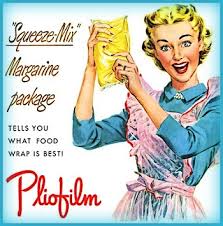 After America’s entry into World War II, sales of all margarines exploded. The John F. Jelke Company led the pack. The United States government continued its purchase of margarine for shipment to England, Russia and other beleaguered European countries. Within months after Pearl Harbor, the American public faced shortages of commodities like gasoline, meat, sugar and butter. Rationing was introduced to control supply and demand. Many consumers opted to purchase margarine, which was not as heavily rationed as butter: it took 16 red stamp ration points to buy a pound of butter but only six to buy the same weight of the butter substitute. Even the White House confined the use of butter to breakfast. “We are using a good deal of margarine for cooking,” Eleanor Roosevelt told the press a little more than a year after Pearl Harbor, but the butter substitute was still not allowed on the table at any time. Jack Jelke saw the food rationing as another advertising hook. Playing off wartime shortages of other products, a 1943 advertisement for Good Luck margarine bragged that “Quality can cause a shortage, too.” Although margarine was still white to be colored by the consumer at home, during the mid-1940s this task became less burdensome. The dye wafer was replaced first with a capsule of yellow powder and then with a capsule of gelatin food coloring, which was easier to mix into the margarine. A few companies hit upon the idea of selling margarine in a pliable, transparent “squeeze” bag that enabled the consumer to knead the margarine and food coloring inside the bag. Use of the Peters Bag made mixing much cleaner and easier.
After America’s entry into World War II, sales of all margarines exploded. The John F. Jelke Company led the pack. The United States government continued its purchase of margarine for shipment to England, Russia and other beleaguered European countries. Within months after Pearl Harbor, the American public faced shortages of commodities like gasoline, meat, sugar and butter. Rationing was introduced to control supply and demand. Many consumers opted to purchase margarine, which was not as heavily rationed as butter: it took 16 red stamp ration points to buy a pound of butter but only six to buy the same weight of the butter substitute. Even the White House confined the use of butter to breakfast. “We are using a good deal of margarine for cooking,” Eleanor Roosevelt told the press a little more than a year after Pearl Harbor, but the butter substitute was still not allowed on the table at any time. Jack Jelke saw the food rationing as another advertising hook. Playing off wartime shortages of other products, a 1943 advertisement for Good Luck margarine bragged that “Quality can cause a shortage, too.” Although margarine was still white to be colored by the consumer at home, during the mid-1940s this task became less burdensome. The dye wafer was replaced first with a capsule of yellow powder and then with a capsule of gelatin food coloring, which was easier to mix into the margarine. A few companies hit upon the idea of selling margarine in a pliable, transparent “squeeze” bag that enabled the consumer to knead the margarine and food coloring inside the bag. Use of the Peters Bag made mixing much cleaner and easier.
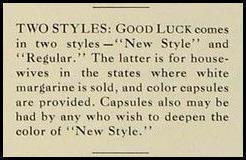 By the end of the war, margarine was a commonly accepted staple of the American kitchen, and Good Luck Margarine had been established as one of the preferred brands of oleo. Jack Jelke’s business was booming and looked to get better with the post-war recovery. The war rationing ended, and consumer commodities became available again, but America’s tongue, and pocketbook, had become accustomed to oleo. Having fought and defeated Fascism, Americans wanted their bread and margarine. They wanted yellow margarine that could be bought from the shelf not colored in the kitchen. It was only a matter of time before Jack Jelke could fulfill his father’s dream of selling Good Luck Margarine in a deep, buttery hue. But Brody’s grandfather had paid a price for the long hours he had spent building The John F. Jelke Company into an empire. He had become estranged from his wife and four children. The divorce papers were finalized in 1945, and Jelke’s wife of 22 years soon took up residence in Connecticut with their youngest son. The three oldest children by then were living in New York. Jack Jelke had taken good care of his children, raising them in privilege, but he also felt that their mother had coddled and spoiled all of them, particularly the boys. Like his father before him, he wanted his children to join the family business and continue its legacy, but none of his offspring cared for the toil of the oleo world.
By the end of the war, margarine was a commonly accepted staple of the American kitchen, and Good Luck Margarine had been established as one of the preferred brands of oleo. Jack Jelke’s business was booming and looked to get better with the post-war recovery. The war rationing ended, and consumer commodities became available again, but America’s tongue, and pocketbook, had become accustomed to oleo. Having fought and defeated Fascism, Americans wanted their bread and margarine. They wanted yellow margarine that could be bought from the shelf not colored in the kitchen. It was only a matter of time before Jack Jelke could fulfill his father’s dream of selling Good Luck Margarine in a deep, buttery hue. But Brody’s grandfather had paid a price for the long hours he had spent building The John F. Jelke Company into an empire. He had become estranged from his wife and four children. The divorce papers were finalized in 1945, and Jelke’s wife of 22 years soon took up residence in Connecticut with their youngest son. The three oldest children by then were living in New York. Jack Jelke had taken good care of his children, raising them in privilege, but he also felt that their mother had coddled and spoiled all of them, particularly the boys. Like his father before him, he wanted his children to join the family business and continue its legacy, but none of his offspring cared for the toil of the oleo world.
The eldest child was called Lana. In July 1944, Lana, 21, eloped with Michael James Brody of Pittsburgh. The two had met a few months earlier in Mexico City, where Brody was pursuing graduate studies in economics. He was a Harvard man, class of 1942. Tall, muscular and handsome with Sinatra-blue eyes, Brody had transferred to Harvard from the Naval Academy and graduated at age 28. He was coy about the years before he entered the Naval Academy. At Harvard, he lived at Kirkland House and was known for being a ladies man. After marrying Lana in Illinois, Brody returned immediately to Mexico City to complete his studies. Lana joined him sometime thereafter. Jack Jelke was uncertain of his son-in-law. He was not really oleo material, and the business could not be left to Lana, for women were not generally suited for the business world in his view. Though he was not happy about the elopement, or even the marriage, the elder Jelke gave his daughter and son-in-law a generous wedding gift to start their life together. The newlyweds headed east to Long Island, where the groom tried to make a go on Wall Street. His economics background gave him a leg up, but his investments did not fare well, and, despite the post-war boom, he soon lost much of the money given them by Jack Jelke for their wedding. The young couple had to manage on a trust fund set up by Lana’s grandfather and gifts from Lana’s mother. Two years after her marriage to Brody, Lana gave birth to a daughter, Robin Clarke.
Jack Jelke’s second eldest child, John F. Jelke III, was called Johnny. He grew to be a handsome young man with dark hair and a nice smile. He enjoyed beautiful women and the night life that was emerging in New York City. But Johnny had a serious side, and a passion for flying. He had flown over 40 combat missions as a pursuit pilot during World War II and was highly decorated, being awarded the Army Air Medal with three Oak Leaf Clusters, the Purple Heart and six combat stars on his European Campaign Ribbon. After the war, he joined the Air National Guard and rose to the rank of first lieutenant. Johnny spent some time at Trinity College. He was an indifferent student and had no intention to parlay the education into anything productive, certainly not the oleo business. He took an apartment in New York City, with financial help from his mother, and he spent most of his nights enjoying the nightclub scene. The City was convenient to White Plains, the home base for his Air National Guard unit, and he was able to get into the air whenever he wanted. The 107th Fighter Wing had P-51 Mustangs, the same plane he had flown in the European Theater. He felt safe flying, far away from the pressures of his father. Though he did not work, the trust fund set up by his grandfather, along with monthly gifts from his mother, were enough to keep him living the life of a playboy.
The third child, Charles, was nicknamed Chuck. He liked steeplechase horses and polo ponies. And he liked to drink, a habit he had picked up in the Navy during the War. Like his brother Johnny, Chuck had no intention of working, particularly in the oleo business. He liked money, of course, because it kept him in horses. And like Johnny, he was satisfied living off trust income and gifts from his mother. He spent time in New York but preferred the warmth of Palm Beach, where he stabled some of his ponies. Jack Jelke’s youngest son, Minot, was 15 when the divorce was finalized. The young boy, called Mickey, was also not oleo material. He was spoiled, a mama’s boy.
After the divorce, Jack Jelke stayed in Chicago at the helm of the family company and began planning for the expansion of his oleo empire. But with no heir to take over the Good Luck business, he soon decided to get out of margarine. Victory for the margarine forces was apparent, and victory meant opportunity.